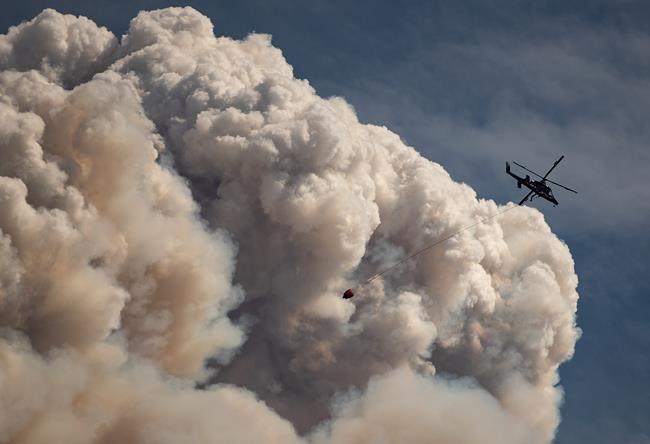The manager of fire operations for British Columbia's wildfire service says rain and cooler temperatures have taken an edge off some of the most aggressive blazes among more than 260 burning across the province.Â
Todd Nessman says the reprieve was welcome after winds fanned fire growth over the weekend, including at the White Rock Lake fire, which destroyed as many as 70 properties near the western banks of Okanagan Lake.Â
He says rain fell on some crucial areas that have been in a prolonged drought and the forecast this week looks favourable, though the moisture will be short-lived as the landscape dries out.
Nessman says the rain isn't enough to reverse the impacts of the very hot and dry spring and summer seasons.Â
The Regional District of Central Okanagan says crews have made substantial progress battling the Mt. Law fire outside West Kelowna, where one structure was significantly damaged along with one previously damaged outbuilding.Â
It says evacuation orders due to the fire, measured at about eight square kilometres, have been partially downgraded and most residents have been allowed to return home, with the exception of 17 properties on the outskirts of the Glenrosa neighbourhood.Â
The district says it was contacting property owners on Tuesday to inform them about the state of their homes along the northwest side of Okanagan Lake after the White Rock Lake fire swept through the communities of Killiney and Ewings Landing late Sunday or early Monday.Â
The same fire, which now measures more than 780 square kilometres, raced through the communities of Monte Lake and Westwold earlier this month, destroying homes and properties.Â
Evacuation orders and alerts issued over the last two days are still posted for many cities, towns and districts in the southern Interior threatened by several wildfires, including blazes near West Kelowna, Merritt and Kamloops.
The B.C. government has extended the provincial state of emergency through the end of this month to support the ongoing response to wildfires.
Public Safety Minister Mike Farnworth says in a statement the province is "taking every step possible to ensure the safety of everyone" in communities affected by wildfire, while travellers are urged to stay away until the situation stabilizes.
The Coquihalla Highway, also known as Highway 5, reopened Tuesday after a wildfire cut off the route between Hope and Merritt on Sunday.Â
However, Highway 1 remains closed because of a mudslide that washed over that route about 30 kilometres north of Lytton.
Drive BC, the province's online travel information service, says a geotechnical survey of the Highway 1 slide is planned, but there's no word when the highway could reopen and no confirmation of what caused the slide.
Highway 3, the other major artery between the Lower Mainland and the Interior, remains open, but it's shrouded by thick smoke from a fire burning between Hope and Princeton.
Forty firefighters and four supervisors arrived in B.C. from Yukon on Monday, raising the total number of out-of-province firefighters to more than 500, including crews from Australia, Mexico, the Prairies, and central and eastern Canada.
The latest numbers from the B.C. government show 8,262 properties around the province were on evacuation order, a leap of nearly 2,000 since Friday, while residents of almost 23,000 more homes must be ready to leave on short notice.
Nearly 8,250 square kilometres of trees, bush and grassland have been charred by more than 1,500 fires since the start of the wildfire season, Nessman says. The 10-year average for the same period is 1,036 fires and about 2,000 square kilometres burned.Â
This report by The Canadian Press was first published Aug. 17, 2021.
The Canadian Press

